新人教版三年级英语下册第四单元第五课时
人教版三年级下册英语Unit 4教案

Unit 4Where is my car?单元教材及学情分析1.单元教材分析本单元的学习围绕一个游戏展开,讲的是几个小朋友在玩我藏你猜的游戏,并由这个游戏引出要学的介词in, on, under。
同学之间玩这个游戏,分别说出物品的具体位置。
如:in the desk, on the chair,并引出问句:Where is…?用英语和自己的小伙伴玩捉迷藏的游戏,对学生来说充满了乐趣。
本课学习的知识点接近实际生活,能够调动学生学习的积极性,有利于教师教学活动的开展。
在Part A中主要讲张鹏和约翰放学后收拾书包的情景。
运用表演的方式能更加自然地呈现句子和单词,目的是让学生明白在我们的实际生活中也可以运用同样的对话来交流,创设学生运用英语的场景,让学生在日常生活中能够做到多运用,多练习,达到掌握第二语言的目的。
在Part B部分,课文以一个小男孩寻找东西并问妈妈的故事开头,比较接近学生的实际生活。
妈妈给他指的几个方位也是学生最容易忘记的地方。
在Part C部分运用学生比较感兴趣的动物对话的方式提高学生学习的兴趣。
2.学情分析教材中出现的主人公是学生在之前的学习中已经熟知的人物,内容也是学生喜欢的。
这让学生感觉到教材有连续性,对学生感知故事情节,理解故事内容很有利。
教学中将重点放在让学生在情景中体验对话,多说多听,以生生互动的形式让学生体验开口说英语的乐趣,从而达到灵活运用的目的。
单元教学目标1.知识目标(1)能够听懂、会说句型:Where is…? It's in/on/under… Is it in/on/under…?Yes, it is./ No, it isn't.(2)能够听、说、认读单词:desk, chair, in, on, under, cap, ball, car, boat, map。
(3)知道元音字母o在单词中的发音。
2.能力目标(1)能够在图片、实物或情景的帮助下运用句型Where is…? It's in/on/under…来询问物品位置并回答。
人教版新课标PEP《小学英语 三年级下册》说课稿Unit 4 Do you like pears A Let’s talk of说课稿(英文版)
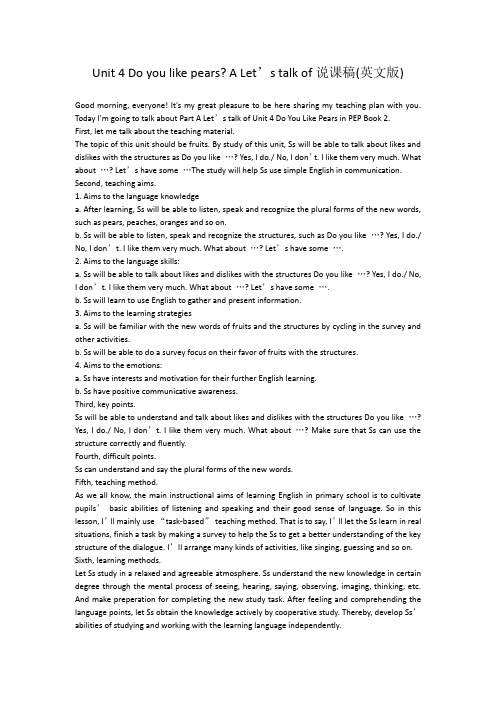
Unit 4 Do you like pears? A Let’s talk of说课稿(英文版)Good morning, everyone! It's my great pleasure to be here sharing my teaching plan with you. Today I'm going to talk about Part A Let’s talk of Unit 4 Do You Like Pears in PEP Book 2.First, let me talk about the teaching material.The topic of this unit should be fruits. By study of this unit, Ss will be able to talk about likes and dislikes with the structures as Do you like …? Yes, I do./ No, I don’t. I like them very much. What about …? Let’s have some …The study will help Ss use simple English in communication. Second, teaching aims.1.Aims to the language knowledgea. After learning, Ss will be able to listen, speak and recognize the plural forms of the new words, such as pears, peaches, oranges and so on.b.Ss will be able to listen, speak and recognize the structures, such as Do you like …? Yes, I do./ No, I don’t. I like them very much. What about …? Let’s have some ….2.Aims to the language skills:a. Ss will be able to talk about likes and dislikes with the structures Do you like …? Yes, I do./ No, I don’t. I like them very much. What about …? Let’s have some ….b. Ss will learn to use English to gather and present information.3. Aims to the learning strategiesa. Ss will be familiar with the new words of fruits and the structures by cycling in the survey and other activities.b. Ss will be able to do a survey focus on their favor of fruits with the structures.4. Aims to the emotions:a. Ss have interests and motivation for their further English learning.b. Ss have positive communicative awareness.Third, key points.Ss will be able to understand and talk about likes and dislikes with the structures Do you like …? Yes, I do./ No, I don’t. I like them very much. What about …? Make sure that Ss can use the structure correctly and fluently.Fourth, difficult points.Ss can understand and say the plural forms of the new words.Fifth, teaching method.As we all know, the main instructional aims of learning English in primary school is to cultivate pupils’basic abilities of listening and speaking and their good sense of language. So in this lesson, I’ll mainly use “task-based”teaching method. That is to say, I’ll let the Ss learn in real situations, finish a task by making a survey to help the Ss to get a better understanding of the key structure of the dialogue. I’ll arrange many kinds of activities, like singing, guessing and so on. Sixth, learning methods.Let Ss study in a relaxed and agreeable atmosphere. Ss understand the new knowledge in certain degree through the mental process of seeing, hearing, saying, observing, imaging, thinking, etc. And make preperation for completing the new study task. After feeling and comprehending the language points, let Ss obtain the knowledge actively by cooperative study. Thereby, develop Ss’abilities of studying and working with the learning language independently.Seventh, teaching aids.I will use the multimedia player and a colourful picture of a fruit shop. And I’ll also make a lively PPT which can attract Ss’attentions very well.Eighth, teaching procedures and purposes of my designing.I’ll teach this lesson in 5 parts.Part I. Warm-upAs language can be learned gradually but not immediately, it’s important for the teacher to find out the links between the language learnt and the new language items. It can lead Ss into the new language items naturally. In this class, Ss will sing a song and take part in free talk with the teacher to recall their memories. Ss will be guided to understand the questions What colour do you like? Do you like …? What about …? and try to express their own favors of colours with the structures I like …Yes./ No.Part II. PresentationThe main purpose of this step is to present new language items. Usually we’d better put it under a real situation.In this class, I will use a big picture of a fruit shop, and show small parts of it. They are in different colours and can help Ss guess What’s in the picture? According to Ss’answer, the new words of fruits will be showed. And next, there will be a quick-response activity which focus on the new words. Then the whole picture will be showed. It will brings Ss into a situation In a fruit shop. I think the way of presentation can really arouse Ss’interests very well. And Ss will be able to understand and say the plural forms of the fruit words with the structures learnt in Unit 3 How many …can you see? I can see …. Guide Ss to pay more attention on their pronunciation. With the help of the lively picture, I will ask S what they like and if they like pears/…. While asking and answering, I will use expression, gesture to help present the target language Do you like …? What about …? and acts as a demonstrator. At that time, three facial expression cards will be presented. I will use to present Yes, I do. Use to present No, I don’t. Use to present Yeah, very much. When Ss have understood the structures, I will get the class to repeat it all together.After that, Amy and her mother will be introduced. Ss will try to find Amy’s likes and dislikes by listening to the tape of Let’s talk. According to Ss’feedback, I will show the class a copy of the questionnaire grid and fill in the blanks as a demonstration.FruitName pears peaches oranges watermelons applesAmyAnd next Ss will watch the video to understand the whole dialogue and learn to read the dialogue correctly. Then Ss will try to act out the dialogue in pairs.Part Ⅲ. PracticeThe main purpose of this step is to help Ss learn the language items by heart and make the language relevant, practical, and communicative.Task 1: Make a new dialogueHowever, as any children’s teacher will know, it is important for Ss to learn a lot more thanEnglish in their English classes. Not only for the intellectual but also the emotional development. So I will guide Ss to make a new dialogue between Amy and her mother. For example, Amy asks her mother: Mom, do you like …? What about …? Let’s have some …Task 2: Make a new chantWe have all experienced that music an rhythm make it much easier to imitate and remember language than words which are ‘just spoken’. So I will present a chant and guide Ss to make a new chant by themselves.For example:Do you likepeaches? Do you likepeaches?Yes, I do. Yes, I do. / Yeah, very much. Yeah, very much.Do you likeoranges? Do you like oranges?No, I don’t. No, I don’t.Task 2: Make a surveyAs we know, younger learners respond to language according to what it does or what they can do with it, rather than treating it as an intellectual game or abstract system. It is important to bear in mind that children need to see the reason for doing the activity, for example, to find information in order to make a survey. Give out copies of the questionnaire grid and guide Ss to ask their neighbours for information.FruitName pears peaches oranges watermelons applesLet’s havesome …Part Ⅳ. ConsolidationAs to this step, the main purpose is to consolidate what Ss have learned during the class and deal with the exercises of the workbook.Part Ⅴ. HomeworkIn order to extend Ss’ability of using English, I think it’s necessary to give Ss some good and proper homework. And according to Ss’level, it should be largely orally based. So I will ask Ss to do a family survey and try to use English as more as possible.Above is the lecture notes of my lesson. Thank you very much!。
新人教版小学三年级英语下册教案
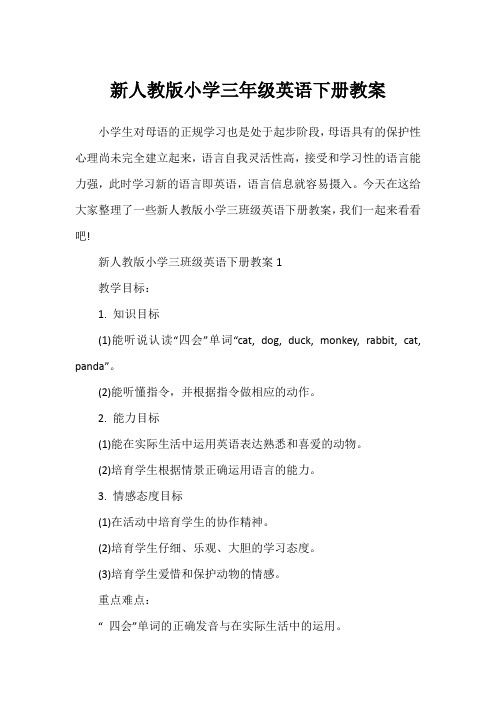
新人教版小学三年级英语下册教案小学生对母语的正规学习也是处于起步阶段,母语具有的保护性心理尚未完全建立起来,语言自我灵活性高,接受和学习性的语言能力强,此时学习新的语言即英语,语言信息就容易摄入。
今天在这给大家整理了一些新人教版小学三班级英语下册教案,我们一起来看看吧!新人教版小学三班级英语下册教案1教学目标:1. 知识目标(1)能听说认读“四会”单词“cat, dog, duck, monkey, rabbit, cat, panda”。
(2)能听懂指令,并根据指令做相应的动作。
2. 能力目标(1)能在实际生活中运用英语表达熟悉和喜爱的动物。
(2)培育学生根据情景正确运用语言的能力。
3. 情感态度目标(1)在活动中培育学生的协作精神。
(2)培育学生仔细、乐观、大胆的学习态度。
(3)培育学生爱惜和保护动物的情感。
重点难点:“ 四会”单词的正确发音与在实际生活中的运用。
课前准备:有关教学课件,动物头饰,小火车图片,小红旗,大萝卜模型。
教学步骤:Step 1: Warm-upa. Sing a song: Teddy Bear 设计意图:课前唱英文歌曲,老师和学生一起演唱并配上相应的动作,用表情、动作、眼神和学生沟通,使学生情绪兴奋,快速进入“角色”,全身心地准备学习的开始。
b. Free talk. 设计意图:师生间的日常会话沟通,培育学生用英语思维,用英语交际的能力。
c. Today we are going to learn some new words. Look, here comes a train(老师手拿一列小火车介绍).There are some numbers on it(手势指向各小组)。
Number 1 is for group 1; Number 2 is for group 2; Number 3 is for group 3; Number 4 is for group4.(老师拿出一面小红旗)If you do very well, you can get a red flag for your group. Lets see which group is the best. OK?(老师以手势鼓动学生回答:OK.)设计意图:小学生好胜心强,从开始就把竞争机制引入课堂,并贯穿于整堂课,大大激发了学生的学习爱好,有利于学生完全投入到课堂活动中来。
最新人教版pep英语三年级下册单元知识点归纳
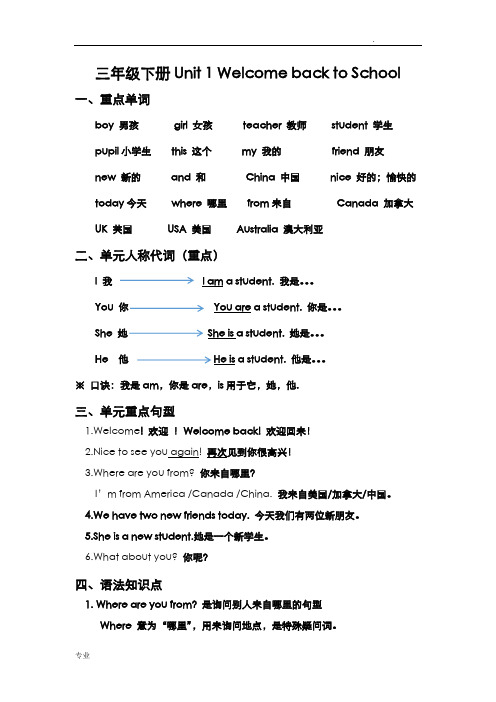
三年级下册Unit 1 Welcome back to School 一、重点单词boy 男孩girl 女孩teacher 教师student 学生pupil小学生this 这个my 我的friend 朋友new 新的and 和China 中国nice 好的;愉快的today今天where 哪里from来自Canada 加拿大UK 英国USA 美国Australia 澳大利亚二、单元人称代词(重点)I 我I am a student. 我是。
You 你You are a student. 你是。
She 她She is a student. 她是。
He 他He is a student. 他是。
※口诀:我是am,你是are,is用于它,她,他.三、单元重点句型1.Welcome! 欢迎!Welcome back! 欢迎回来!2.Nice to see you again! 再次见到你很高兴!3.Where are you from? 你来自哪里?I’m from America /Canada /China.我来自美国/加拿大/中国。
4.We have two new friends today. 今天我们有两位新朋友。
5.She is a new student.她是一个新学生。
6.What about you? 你呢?四、语法知识点1.Where are you from?是询问别人来自哪里的句型Where 意为“哪里”,用来询问地点,是特殊疑问词。
From “来自”的意思例如:Where is she from?她来自哪里?Where are you from?你来自哪里?2.I’m from.....是介绍自己来自哪里的句型。
I’m from +国家/城市/地名例如:I’m from Jiangxi.3.have 的用法(1)have可以表示“吃,喝”例如:Have some bread. 吃些面包吧。
2023学年人教PEP版三年级英语下册 Unit 4 第5课时 公开课教案

2023学年人教PEP版三年级英语下册 Unit 4 第5课时公开课
教案
教学目标
•知道单词所表示的动物和颜色。
•能够口头描述所给的图片。
•能够模仿老师的发音并朗读单词。
教学重点
•学习颜色,如红色、黄色等。
•认识第六只动物。
教学难点
•能够口头描述所给的图片。
教学准备
•多媒体设备。
•单词卡片。
教学过程
1.课前热身 (5分钟) 在课前准备阶段,老师可准备一些颜色卡片,呈现给学生看,同时口头让学生说出颜色的英文,并做出相应的手势。
2.学习动物 (10分钟)
•呈现动物图片,让学生说出动物的英文并模仿老师的发音。
•通过问答的形式,巩固学生对动物单词的掌握程度。
3.学习颜色 (10分钟)
•呈现颜色图片,让学生说出颜色的英文并模仿老师的发音。
•通过问答的形式,巩固学生对颜色单词的掌握程度。
4.学习句型 (10分钟)
•呈现图片,并引导学生描述图片,例如。
人教版英语三年级下册第四单元的汉语解释

人教版英语三年级下册第四单元的汉语解释In the fourth unit of the third grade English textbook of People's Education Press, students will learn about different types of weather and how to describe them. This unit aims to help students develop their vocabulary related to weather, as well as their ability to describe different weather conditions. Let's explore the content of this unit in detail.The unit begins with an introduction to different weather conditions. Students will learn about sunny, cloudy, windy, rainy, snowy, and stormy weather. They will also learn how to use adjectives to describe these weather conditions. For example, they will learn that sunny weather is bright and hot, while rainy weather is wet and gloomy.Next, students will learn about different activities that can be done in different weather conditions. They will learn that on a sunny day, they can go swimming, have a picnic, or play outdoor games. On a rainy day, they can stay indoors and read books, play board games, or watch movies. They will also learn about the appropriate clothing for different weather conditions. For example, they will learn that they need to wear a raincoat and carry an umbrella on a rainy day.After that, students will learn about different seasons and the weather associated with each season. They will learn that spring is warm and sunny, summer is hot, autumn is cool and windy, and winter is cold and snowy. They will also learn about the activities and clothing associated with each season. For example, they will learn that in spring, they can fly kites and wear light jackets.In addition to learning about weather and seasons, students will also learn about different weather-related expressions and idioms. They will learn expressions such as "It's raining cats and dogs" and "Under the weather." They will also learn about idioms such as "Every cloud has a silver lining" and "A storm in a teacup." These expressions and idioms will help students expand their vocabulary and understand the cultural aspects related to weather.Throughout this unit, students will engage in various activities to practice their language skills. They will listen to weather forecasts, read weather reports, and participate in role plays to describe different weather conditions. They will also have opportunities to write about their favorite weather and the activities they enjoy doing in different weather conditions.By the end of this unit, students will have developed a solid understanding of different weather conditions, seasons, and related vocabulary. They will be able to describe different weather conditions accurately and confidently. This unit provides a foundation for further learning in the areas of weather and seasons, as well as developing students' overall English language skills.In conclusion, the fourth unit of the third grade English textbook of People's Education Press focuses on teaching students about different weather conditions, seasons, and related vocabulary. Through various activities and exercises, students will learn how to describe different weather conditions accurately and confidently. This unit aims to develop students' language skills and expand their knowledge of weather and seasons.。
新版人教版PEP小学英语三年级下册全册教案

第三课时教学内容:(A)Let's spellLet’s chant教学目标:1、Let’s spell达到对单词拼写的练习。
2、Circle圈出听到的单词。
3、write,练习书写四个简单单词。
教学重点:1、通过listen,repeat and chant达到对单词拼写的练习。
2、Circle圈出听到的单词。
3、write,练习书写四个简单单词。
教学难点:元音字母u在单词中的发音。
教学过程:1、播放Let’s spell的录音,让学生听歌谣。
2、让学生跟着动画学说歌谣,同时可用手打节奏。
3、播放Let’s circle的录音,让学生圈出正确的单词。
4、听音后反复读四个单词,在此基础上进行描红,达到书写格式正确的目的。
5、自学49页的let’schant;在会读的基础上,理解意思,结合上下文说说yummy的意思。
当堂训练1、教师将orange, OK, peach, pear, queen, quiet的单词卡贴在黑板上,举起其中一张卡片,让学生看词,请一名学生读单词,让学生在教师提供的空白纸上画图。
教师出示一个单词,学生画一张图。
2、看谁拿得快。
出示磁卡,让学生拿图片,拿的快的积分。
计算最后结果,给与优胜小组奖励。
板书:Unit5Do you like pears?(A)Let's spellLet’s chantfunrunduckunder教学反思:Unit5 Do you like pears?第四课时教学内容:(B)Let's talkLet’splay教学目标:1.理解并掌握"Can I have…?""Thanks""Here you are"等语言知识;2.理解"Can I have…?""Sorry.的含义;并在生活中得体地运用。
教学重点:理解"Can I have…?""Sorry.的含义;并在生活中得体地运用。
三年级【英语(人教版)】Unit 4 Pets 第五课时-2PPT课件

A pet needs exercise.
A pet needs exercise.
A pet needs your love.
Let’s listen and repeat. (Page 45)
…
… … Let’s listen and repeat. (Page 45)
Let’s listen and repeat. (Page 45)
Self-assessment(自我评价)
1.我能够了解宠物的需求:水、食物、
运动和主人的爱,知道如何照顾宠物。
2.我能够制作一张宠物需求单,并进 行简单介绍。
课后练习
1.听一听,读一读。
2.动动手,做一做。
谢 谢!
02 Let’s learn.
A pet needs food.
What food does a cat need?
What food does a dog need?
What food does a chicken need?
?
My pet is a dog. A dog needs dog food and bones.
ห้องสมุดไป่ตู้
03 Let’s learn more.
Henry
Toby
What does Toby need?
water
dog food
a bed
dog treats exercise
a bath
love
04 Let’s make.
Summary
What does a pet need? A pet needs water.
Lesson 5 What does a pet need?
新人教版PEP小学英语三年级下册第四单元partA-let's-learn说课+授课复习课程

教学步骤和设计
我的整个教学过程主要分为 热身(Warm-up)、 呈现(Presentation)、 操练(Practice)、 巩固(Consolidation) 四个部分来进行。
(一)热身(Warm-up)
1、Greeting.
2、 Talking.( 出示课件,one picture about Mike)课前导入采用Free talk的形式更有利于学 生从母语环境迅速进入英语学习状态。通过创设 情境的方式讨论图片问题,自然过渡到新课。
(二)呈现(Presentation)
1、The words
1)学习单词desk、chair:通过询问在zip的房间 看到了什么自然引出单词desk和chair。 2)通过zip的三个问题呈现今天的句型,从而引 出方位介词on、in、under。
3、教学手段
根据学生的年龄特点和本课内容,我主要采用实 物、图片、单词卡片以及教师丰富的体态语言等 教学手段进行教学,它们能活化教材,辅助教师 对教学内容进行有序讲解,在讲解的过程中,能 充分利用有效的教学时间,改善信息的传递方式, 增强信息的传递能力,使外语学习变得生动活泼, 加深学生对教学内容的理解。
三年级下册
Unit 4 Where is My Car?
Part A Let’s learn
说 课稿
145269030邱素贞
说教材分析 说教法、学法
说教学目标 说教学重点难点
说教学步骤与设计 结束
一、说教材
本课内容出自新PEP教材三年级下册第四单元《Where is my car ?》,第二课时包括Let’s learn。主要教学五 个单词in、 on、 under、chair 、 desk,并能根据指令 做出相应的动作。教学实践中我们发现:基于学生学习心 理和各阶段身心发展特点,很多相关的知识点采取了分散 教学的方法,让学生循序渐进地掌握。本单元是学生学习 PEP教材过程中,第二次遇到关于方位的话题,是上册运 用英语谈论方位的巩固和延续,为以后学习其他方位词作 铺垫,起着承上启下的作用。本课时是单词和句型的教学。
人教版三年级英语下册课时作业含答案Unit4

⼈教版三年级英语下册课时作业含答案Unit4⼈教版三年级英语下册课时作业含答案CONTENTSUnit1Welcome back to school!Unit2My familyUnit3At the zooRecycle1Unit4Where is my car?Unit5Do you like pears?Unit6How many?Recycle2Words in each unitVocabularyUseful expressions第⼀课时⼀、给下列图⽚选出合适的单词,补全表格。
A.underB.inC.bookD.desk()()()()⼆、单项选择。
()1.Where________my pencil?A.amB.areC.is()2.It’s________your desk.A.deskB.underC.Chair()3.Silly________!A.IB.meC.my()4.—Let’s go home.—________A.OK!B.Uh—oh!C.Oh!三、翻译下列句⼦。
1.Where is my pencil box?________________________________________________________ 2.It’s in your desk.________________________________________________________ 3.It’s under your book.________________________________________________________ 4.Let’s go home.________________________________________________________第⼆课时⼀、汉译英。
1.在桌⼦上______________________2.在椅⼦上_________________________3.在课本下______________________4.在书包⾥_________________________⼆、单项选择。
人教版PEP小学英语三年级下册Unit4单元教材分析及教案

⼈教版PEP⼩学英语三年级下册Unit4单元教材分析及教案PEP2 Unit4 单元教材分析⼀、教学内容:本单元以“寻找物品”这⼀话题,展开“Where?”的问答活动,引出表⽰⽅位关系的介词“in,on,under”和表⽰家庭中常见物品的单词。
“东西在哪⾥”这⼀话题与学⽣的⽇常⽣活密切相关,符合学⽣的⼼理年龄特征。
教学时,教师要创设符合⽣活实际的情境,利⽤⽣活中的实物,辅以歌谣、趣味性较强的⼩游戏等活动,充分体现学⽣的主体地位,体现英语教学的趣味性和实效性。
同时教师要注意让学⽣通过完成任务型活动感知新的语⾔点,培养学⽣的语⾔运⽤能⼒。
在前三个单元学习的基础上,教师可以借助已学的语⾳知识和拼读能⼒,从“⾳”⼈⼿,帮助学⽣能够根据元⾳字母Oo的短⾳发⾳规律正确拼读相应的词。
C部分的⼩故事有机地整合了本单元的主要词汇和句型,有趣幽默的故事情节引⼈⼊胜在阅读理解的基础上,可以⿎励有能⼒的孩⼦进⾏表演或给故事配⾳。
⼆、教学⽬标1.能够听懂、会说Where is…等询问⽅位的句⼦,并能在实际情景中进⾏运⽤。
2.进⼀步熟悉掌握⼀般疑问句的⽤法。
3.能够听说、认读⼀些⽅位介词及基本⽣活⽤品的单词。
4.能听懂所接触的指⽰语,并能按照指令做出相应的动作。
5.学会课本中的⼀⾸歌曲。
《Where is the toy car?》6.逐步养成⾃⼰收拾书包、玩具的好习惯。
三、教学重难点:⽅位介词的掌握与区别。
四、课时安排每⽇精选三题1. 判断划线部分发⾳是否相同A.catB.cake2.--The panda is from__________.A. the USAB.ChinaC.the UK3. 连词成句①he ②Is ③father ④your ⑤(?)______________________________________________________ PEP Book2 Uni4 Where is my car?Part A Let’s talk⼀、教学内容PEP Book2 Unit4 A Let’s talk and Let’s play⼆、教学⽬标1.能听懂、会说并理解句⼦Where's ...? It's in / on / under....2.在创设的情景中,能⽤ Where's ...? 询问某物在哪⾥,并做简单回答。
人教版PEP三年级英语下册第四单元教案
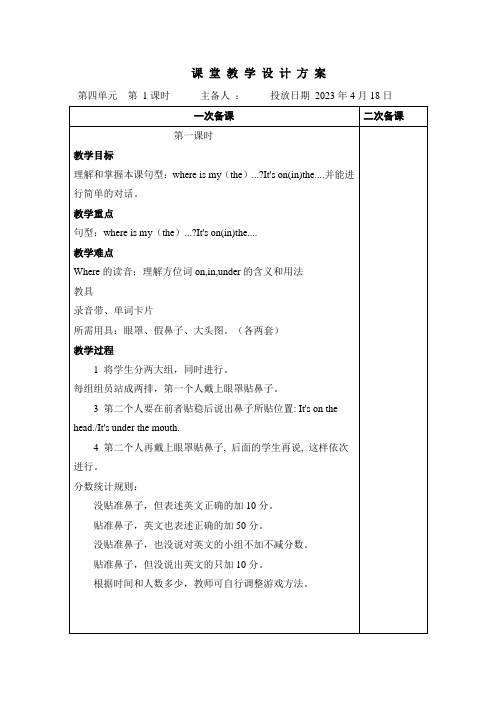
课堂教学设计方案第四单元第1课时主备人:投放日期2023年4月18日教学板书Unit 4 Where is my car?(A) Let's talkWhere is my(the)...?It's on(in)the...作业设计一、选择正确的图片,将其选项填入题前括号内。
( ) 1. in the book A. (麻烦找一张铅笔 B.夹在书里的图片)( ) 2. in the desk A. B. 画一张书在课桌里的图( ) 3. under the desk A. 书在课桌下图 B. 书在课桌里图( ) 4. under the pencil box A.书在文具盒下面 B. 书在课桌下面二、选择正确的单词补全句子。
( ) 1. Where ______ my book?A. isB. theC. are( ) 2. Let’s _______ home.A. goingB. to goC. go( ) 3.Silly ______!A.IB. meC. my教学反思课堂教学设计方案第四单元第2课时主备人: 投放日期2022/4/18Unit 4 Where is my car? (A) Let's learn on in under chair desk作业设计一、 将下列字母按正确顺序排列组成单词,并写在相应图片的下方。
1. e s k d 2. a c h i r 3. u d e r n 4. r l e r u二、根据图片选择正确的单词。
( ) 1.The pencil is ______ the book.A. inB. on( ) 2. The ruler is _______ the pencil box. A. on B. under( ) 3. The ______ is on the desk.A. bookB. pencil box( ) 4. The pencil box is ________ the bag. A. on B. in( ) 5. The book is under the ________.A. chairB. desk教学反思课 堂 教 学 设 计 方 案第四单元 第3课时 主备人 投放日期 2023年4月18日一次备课二次备课 第三课时 教学内容 (A) Let's spell这里需要五个图,每个小题后边放一个。
人教PEP版英语三年级下册第四单元全部课件

Practice
Watch the video.
Let’s do
Put your foot under your chair. Put your hand on your chair. Put your arm in your desk. Put your hand under your desk.
Look at the picture and help the boy. WWW hehhreerreiesisimsmymypyebpnoeconikl??box?
IItIt'ts's'usinnodntehtrehtedhedsebkso.ko.k.
Practice
Play a game. 准备A,B,C三个盒子,A盒子着人名的卡片或者图画,B为方位词的 卡片,C为学过的物品名词。学生随机抽取按照给出的公式造句。
在……里面 Where is the toy bear? It’s on the bookself.
在……上面
Presentation
Let’s talk
Who are they? Where are they?
They are John and Zhang Peng.
They are in the classroom.
( B ) 1.
A. chair
( B ) 2.
A. desk
( A ) 3.
A. in
( B ) 4.
A. on
B. desk B. chair B. under B. under
二、判断下列句子与图片是(T)否(F)相符。 ( T ) 1. The cat is in the jar. ( F ) 2. The dog is under the box. ( T ) 3. The ball is on the box.
新人教版PEP小学英语三年级下册第四单元partA-let's-learn说课+授课

设计目标:
学生充分学会辨别三个词的方位变化 以及熟悉句型,使学生可以在日常生 活的交际中正确使用。
2)根据小学生的心理特点,在课堂
后期我会播放一首与本课所学知识 高度相关的on、in、under英文儿歌, 从而达到寓教于乐。
说板书设计
Where is my car?
• Where is the...? • It’s on / in / under the...
歌曲视频结束后,教师与学生简 单对话同时轻松结束本堂课的内 容。
Unit 4 Where is my car ? A. Let’s learn
放学了,Mike想和同学们一起去zip家里玩。
Where is the ruler?
It’ under the chair.
Where is the bag?
3、教学手段
根据学生的年龄特点和本课内容,我主要采用实 物、图片、单词卡片以及教师丰富的体态语言等 教学手段进行教学,它们能活化教材,辅助教师 对教学内容进行有序讲解,在讲解的过程中,能 充分利用有效的教学时间,改善信息的传递方式, 增强信息的传递能力,使外语学习变得生动活泼, 加深学生对教学内容的理解。
三、说教学目标
1、知识目标 2、能力目标 3、情感态度目标 4、文化意识目标
1、知识目标:
1)能够听、说、认读新单词:desk、 chair、 in、on、 under 。 2)能够听懂会说Where is ……?It’s in /on /under……并能在实际生活中 运用。
2、能力目标:
1)培养学生灵活运用所学知识进行 交流的能力。 2)发展学生听、说、读技能。 3)培养学生综合语言运用能。
3、情感态度目标:
人教版三年级英语下册 课时作业含答案Unit 5
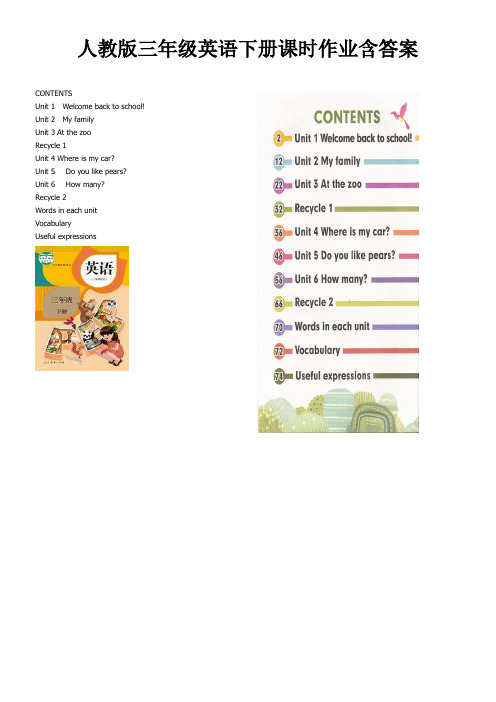
人教版三年级英语下册课时作业含答案CONTENTSUnit 1Welcome back to school!Unit 2My familyUnit 3 At the zooRecycle 1Unit 4 Where is my car?Unit 5Do you like pears?Unit 6How many?Recycle 2Words in each unitVocabularyUseful expressionsUnit 5 Do you like pears?第一课时一、给下列单词选出合适的翻译。
()1. 喜欢 A. like B. have()2. 橙子 A. orange B. yell ow()3. 一些 A. do B. some()4. 梨 A. pencil B. pear()5. 让我们…… A. let B. let’s二、给下列图片选出合适的句子或对话。
()1. ()2. ()3.A. —Do you like apples?—Yes, I do.B. —Do you like pears?—No, I don’t.C. I like oranges. Let’s h ave some oranges.三、单项选择。
()1. ______ you like oranges?A. DoB. Are()2.I ______ like pears.A.isn’tB. don’t()3. ______ have some apples.A. Let’sB. Let()4. I ______ like apples.A. amB. don’t四、情景选择。
()1. 你想知道好朋友喜不喜欢梨,你这样问:_______ A. Do you like apples? B. Do you like pears?()2. 你告诉妈妈你喜欢苹果,你这样说:_______A. I like apples, Mum.B. I like pears, Mum.()3. 你告诉妈妈你不喜欢橙子,你这样说:_______ A.I like oranges, Mum. B. I don’t like oranges, Mum.一、给下列图片选出合适的单词。
PEP小学英语三年级下册第四单元Grade 3 Unit 4 Where is my car 教案
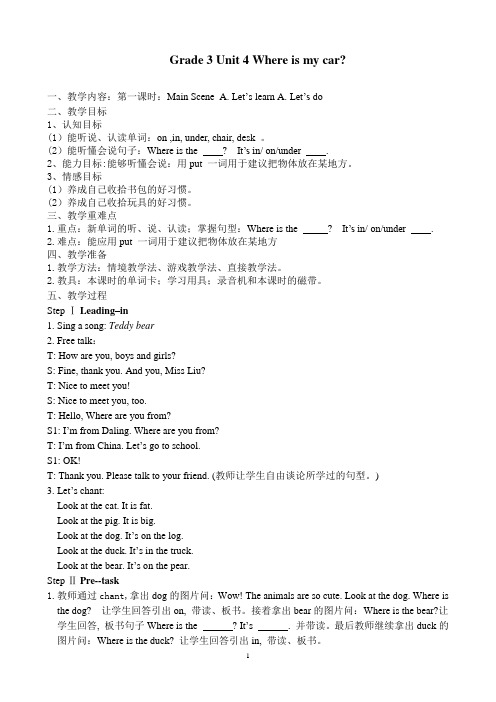
Grade 3 Unit 4 Where is my car?一、教学内容:第一课时:Main Scene A. Let’s learn A. Let’s do二、教学目标1、认知目标(1)能听说、认读单词:on ,in, under, chair, desk 。
(2)能听懂会说句子:Where is the ? It’s in/ on/under .2、能力目标:能够听懂会说:用put 一词用于建议把物体放在某地方。
3、情感目标(1)养成自己收拾书包的好习惯。
(2)养成自己收拾玩具的好习惯。
三、教学重难点1.重点:新单词的听、说、认读;掌握句型:Where is the ? It’s in/ on/under .2.难点:能应用put一词用于建议把物体放在某地方四、教学准备1.教学方法:情境教学法、游戏教学法、直接教学法。
2.教具:本课时的单词卡;学习用具;录音机和本课时的磁带。
五、教学过程Step ⅠLeading–in1. Sing a song: Teddy bear2. Free talk:T: How are you, boys and girls?S: Fine, thank you. And you, Miss Liu?T: Nice to meet you!S: Nice to meet you, too.T: Hello, Where are you from?S1: I’m from Daling. Where are you from?T: I’m from China. Let’s go to school.S1: OK!T: Thank you. Please talk to your friend. (教师让学生自由谈论所学过的句型。
)3. Let’s chant:Look at the cat. It is fat.Look at the pig. It is big.Look at the dog. It’s on the log.Look at the duck. It’s in the truck.Look at the bear. It’s on the pear.Step ⅡPre--task1.教师通过chant,拿出dog的图片问:Wow! The animals are so cute. Look at the dog. Where is the dog? 让学生回答引出on, 带读、板书。
